Verge is another of the privacy-centric cryptocurrencies, focused on privacy and anonymity for its users.
Verge makes its anonymity possible by building its blockchain on top of Tor and I2P services which serve to hide users personal data, such as their IP address and geolocation.
Something else that is interesting and unique about Verge is its proof-of-work consensus algorithm. Unlike many other cryptocurrencies, it uses a combination of different algorithms. All of these consensus algorithms still allow users to mine Verge on their home computer's GPU. This is a huge bonus and this type of home mining works very well if you combine your hash power in a Verge mining pool.
But which pools are the best to join?
In this post, we will take a look at some of the most profitable Verge mining pools as well as give you everything that you need to know about choosing the best pools.
Verge Mining Overview
Verge mining allows the miners to make rewards for securing the Verge network and validate blocks and transactions. It’s also how new Verge tokens are created. While Verge uses 5 different algorithms for mining, they are all Proof-of-Work algorithms. Verge chose to use PoW because it is considered the most secure consensus protocol.
The process of mining uses the processing power of a computer to solve a difficult cryptographic problem. When the problem is solved a new block is discovered, and all the transaction data in that block is validated.
The creation of blocks also rewards the miners with new Verge tokens. Because several of the algorithms are ASIC resistant, Verge can still be mined with a basic GPU. In addition to a graphics card miners also need a Verge wallet and specialized mining software.
Verge Consensus Algorithms
Most cryptocurrencies use just one consensus protocol, so Verge is somewhat unique since it allows for mining with five different algorithms. The algorithms supported by Verge are Scrypt, X17, Lyra2rev2, myr-groestl and blake2s.
Note that the Scrypt algorithm is dominated by ASIC rigs and isn’t really suitable for home mining. Most of the other algorithms will work best with Nvidia cards, with the exception of myr-groestl that performs best with AMD cards. One other possibility is to dual mine Ethereum and Verge, since the Claymore Miner supports dual mining of Blake2s algorithm tokens.
Pool Mining Verge
Because I’m guessing most of you aren’t running ASIC rigs from your home you’ll want to pool mine rather than solo mine. Pool mining allows you to pool your computing resources with other miners around the globe, making it easier and faster to find blocks, and make rewards. Pool mining is very popular for coins that don’t depend on ASIC rigs.

Solo mining, as you might guess from the name, is done on your own, and this makes it unlikely that you’ll have enough hash power to find a block very quickly. The upside of solo mining is that you don’t have to share the reward, but the downside is that it could take months to get any reward.
Sticking with a mining pool will allow you to collect some small reward every day.
Before choosing a pool you’ll need a Verge wallet, because the mining pools will need a wallet address to send your Verge to. You can download Core Wraith Wallets for Windows, Linux and OSX or store your Verge privately on your mobile with the Verge Tor wallet.
Now you can get down to the business of choosing a Verge mining pool. As I mentioned above, most of the algorithms are best for Nvidia cards, but AMD cards can use the myr-groestl algorithm. And the Scrypt algorithm is best avoided since it is dominated by ASIC rigs.
Here are some choices of verge mining pools for each algorithm:
Scrypt
If you’re just stubborn or have some other reason to go with the Scrypt algorithm one very good mining pool is CoinFoundry. It’s not the biggest mining pool, but it’s big enough to find blocks regularly and fairly quickly.
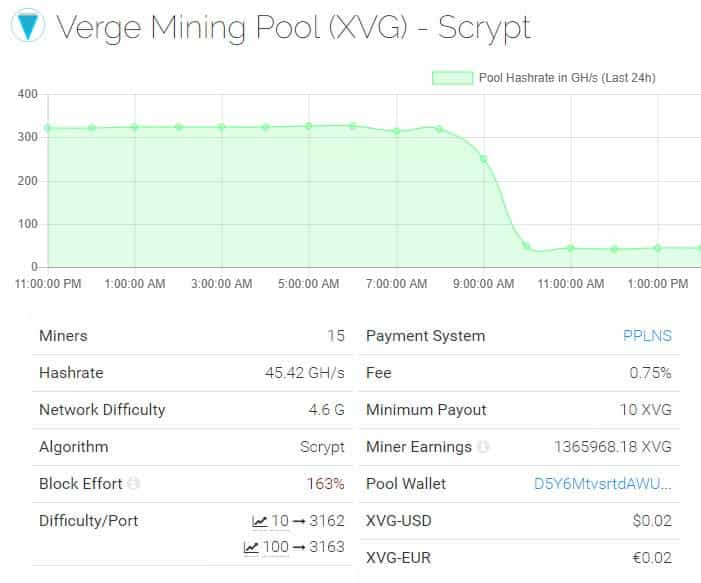
It also has a low 0.75% fee, which is better than most. There are servers located globally, and uptime is 100%. Other Scrypt mining pools for Verge include:
- Block Masters
- Aikapool
- MiningPoolHub.com
- ZPool which also supports Myr-Groestl, Lyra2rev2 and Blake2s
X17
You can also use CoinFoundry to pool mine Verge with the X17 algorithm. If you want a more popular option however, you could choose Suprnova.cc instead. This is a popular pool for many different coins, and is well trusted in the cryptocurrency community.
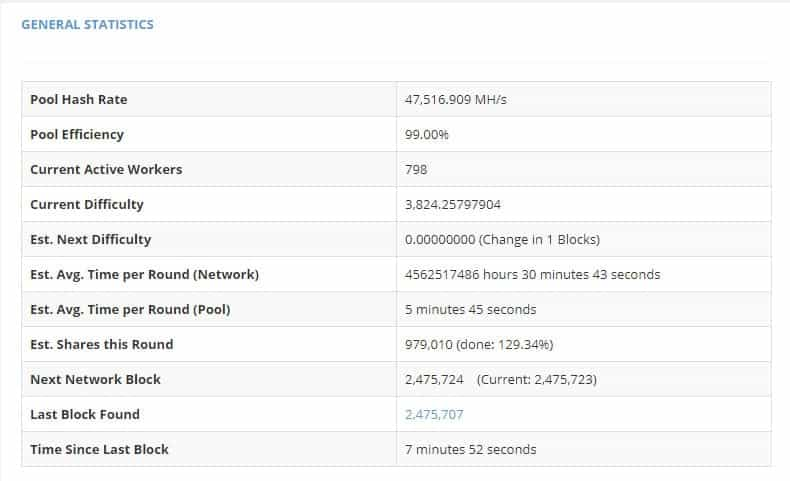
They have a slightly higher fee of 1%, but also have global servers and 100% uptime. You can also use Suprnova to mine on the Myr-Groestl algorithm. Other popular X17 mining pools for Verge include:
- Block Masters
- HashFaster which also supports Lyra2Rev2
- Poolovich
- Yiimp
Myr-Groestl
This is for those out there with AMD cards in their computers. One of the top mining pools for this algorithm is IDCray, which is based in China, but has servers around the world.
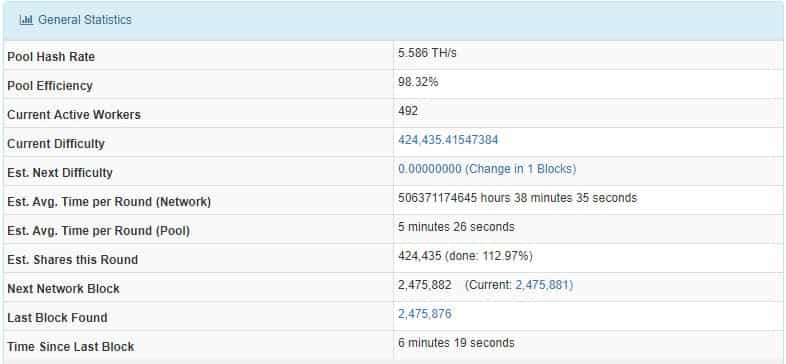
They also have the standard 1% fee and one of the largest myr-groestl mining pools for Verge. IDCray also supports other Verge hashing algorithms on its pools such as Lyra2rev2. There are some other options if you’d like to mine with a pool not based in China:
Lyra2rev2
When using the Lyra2rev2 algorithm you have a number of alternatives, some of which are the same pools that are listed above. One different pool is the Block Masters pool, which is interesting because it has a super low fee of just 0.25%.
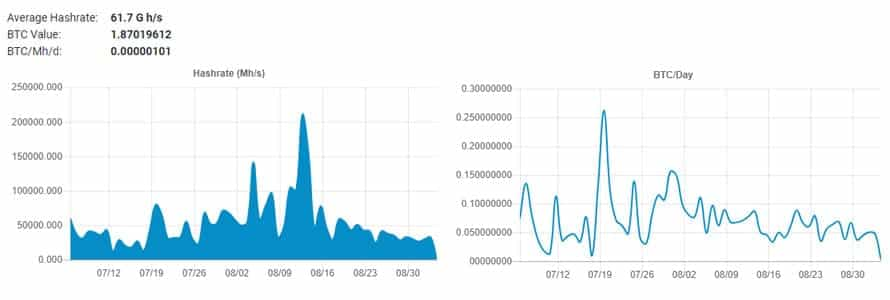
It also has a fairly large number of miners and hash rate, and global servers. I wasn’t able to find uptime information, but it is a favored site among Verge miners so you can bet that it is at or near 100%. Some other options for mining Verge with Lyra2rev2 are:
Blake2s
Last, but not least, we come to the blake2s algorithm. One of the most popular mining pools for this algorithm is the Verge Blake2s CryptoCartel mining pool.
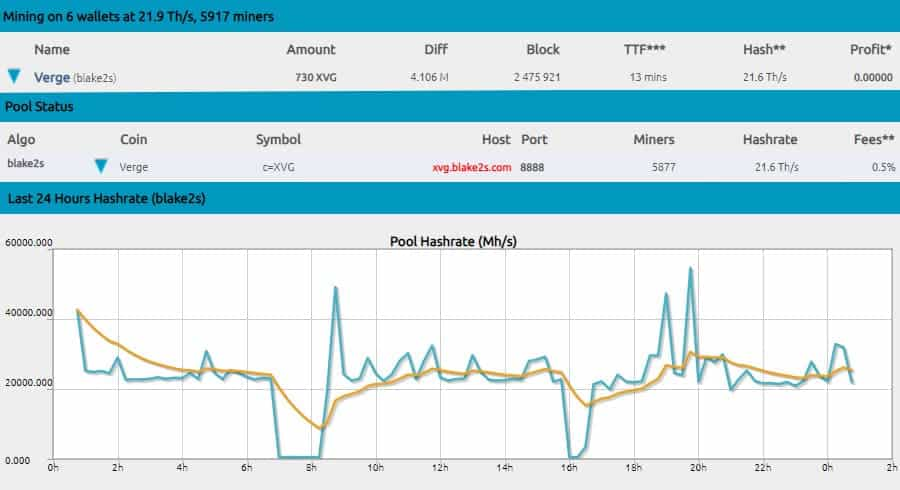
It has a low 0.5% mining fee, and thousands of miners so you know there will be plenty of blocks found. There’s no registration required at the site, which maintains your privacy. If you want to mine somewhere else these sites also support blake2s Verge mining:
Conclusion
Privacy-centric coins have become increasingly popular over the past year, and Verge has been rising right along with other popular privacy coins. With the RSK technology implemented, Verge is one of the only privacy-centric cryptocurrencies that can also do smart contracts. That should give the coin a boost.
From the home mining perspective it’s a great coin because it lets you choose between five different algorithms to mine. While Scrypt isn’t really suited, the other four are, so even if one were to find itself overtaken by ASIC miners there would still be plenty of room for the home miner.
With privacy, anonymity and fast transaction speeds, Verge has quite a lot going for it, and could be one of the coins that ends up as a top contender for regular daily transactions. It’s too early to tell, but mining some at home when you aren’t using your computer anyway certainly won’t hurt.
Disclaimer: These are the writer’s opinions and should not be considered investment advice. Readers should do their own research.



